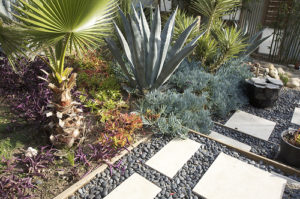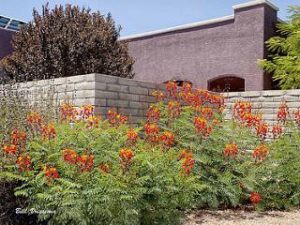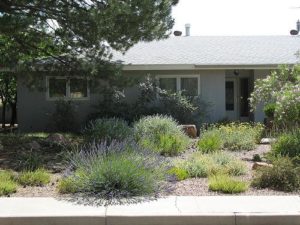by Virginia Morris, El Paso Master Gardener

Credit: via keepingtime_ca (CC BY 2.0)
Have you ever driven around a neighborhood and wondered why one landscape looks gorgeous and another looks “not so good”? Why is one landscape more attractive? Think about the ways we have developed our landscapes. Most of us just go to the nursery, usually in the springtime, and buy plants that appeal to us and put them in whatever space is available. What can the homeowner do to achieve a landscape that looks like a professional designed it? The answer: Think like a landscape architect.
Develop a Concept. What do you want from your landscape? Is your goal water conservation, low maintenance, or a wildlife friendly habitat? How will the landscape be used? Will it be an active recreation area for children’s play, or perhaps an outdoor living room? What are the privacy considerations? How do you want it to look? Do you want a formal cottage garden, a naturally occurring desert look, or a lush Mediterranean appearance? Choose a theme and stick with it! This is absolutely essential to create an aesthetically appealing landscape.
Start with a Plan. Take inventory of the existing lawn, hardscape and plant materials you want to keep. Create a written, “to-scale” plan and incorporate the existing inventory. Putting your plan on paper keeps your focus on the concept you have developed. Always consider the mature size of the plants when incorporating new plant materials with existing plant materials. This will reduce maintenance and ensure plant health. Consider geographic orientation. Select plants according to their planned north, south, east or west exposure.
Irrigate in Zones. Create three plant and irrigation zones: arid, transitional, and mini-oasis. Irrigation efficiency is achieved by grouping plants by their water needs. The arid zone features the most drought tolerant plants and should be located away from the living and recreation areas. The transitional zone is used to blend lush areas with the drier parts of a landscape and takes advantage of low and moderate water use plants. The mini-oasis zone includes the highest water use plants and your lawn area. The shaded north and east sides of your home are best suited for this zone.
Four Seasons of Color. Frequently we visit nurseries in the spring and buy plants that are in bloom at that time. This means we will have a beautiful spring-blooming garden that is not so attractive in the other three seasons. Select a combination of plants that will bloom over at least three seasons and use evergreen plants for winter. This element prevents having a crispy-appearing winter landscape. Consider buying some winter blooming plants.
Passive Rainwater Harvesting. Wherever possible, use arroyos or swales, rain gardens, permeable pavement, or detention basins to slow rainwater run-off thereby allowing filtration into the soil. This is best considered during the planning phase of any project.
Keep in mind, the cost of landscaping is frequently underestimated. Consider a staged approach to implement your landscape design over several years. Your written plan will keep you on track to creating a well-planned, aesthetic landscape everyone can enjoy during every season.
Image sources:
Left: Xeriscape by Jeremy Levine (CC BY 2.0)
Middle: Tucson Barrio Historico by Bill Vriesema (CC BY-NC-ND 2.0)
Right: Pretty by teofilo (CC BY 2.0)


